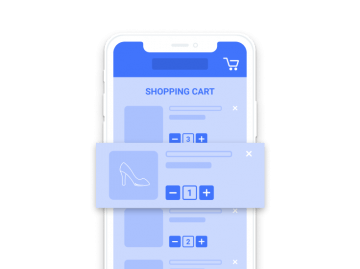What is App Store Optimization
App Store Optimization (ASO) is marketing for mobile applications, i.e. activities aimed at increasing a mobile app’s visibility. The main goal of ASO is to increase the conversion rate for app installation by:
Enhancing the visibility of the application → Increasing traffic on the application page → Boosting installations
Despite the many materials written about good practices in the field of ASO, a number of companies still make some basic mistakes. Perhaps this is because of a lack of knowledge on the subject or perhaps some difficulty in putting theory into practice. So, today we would like to supplement our article on ASO principles with some examples of good and bad practices in this field.
What are good and bad ASO practices
- Choose the right name – keywords contained in the name inform the user about what purpose the application might serve right from the word go. In addition, the store algorithm reads the keywords in the application name which then affects the app’s positioning.
Good practices: Each of the presented brands include the keywords in the title, presenting the main value for the user, which helps them to instantly identify its purpose. It is also a factor which influences the indexation of the application.
Bad practices: Some brands elect not to place an additional description in the name, relying entirely on brand awareness built previously through other communication channels.
- Describe the app including relevant keywords – demonstrating the app’s main benefits and purpose affects whether the user downloads it or not and influences the downloads:traffic ratio, which is an element taken into account by store algorithms. In addition, the Google Play algorithm takes keywords from the full description in the application indexation while in the case of the Apple Store, keywords are entered into a special field.
Good practices: JD Sports has a description that includes the app’s most important functions and purposes that might interest the user. This helps a potential customer see why it might be worth installing it.
Bad practice: No description – it isn’t clear what the application is for and the description doesn’t indicate what the app actually does.
- Choose an attractive and legible icon – this element appears in search results along with a host of other icons, so it has to grab attention.
Good practices: Simplicity, readability, aesthetics. Use the brand name or signet.
- Use aesthetically pleasing graphic materials – icons, screenshots, and video demos show the client how the application looks and why it’s worth installing. Whether or not the customer installs and uses the application depends on aesthetics, readability, and the presentation of functionality.
Good practices: Each application screen is shown in an aesthetically appealing mockup together with a description of the key functions.
Bad practices: Poor screen aesthetics and lack of visible benefits from using the app have a negative impact on its reception.
- Update regularly: Regular updates increase the app’s usability and technological functionality. That’s why if you want to boost retention, you should listen to the users and translate that feedback into improvement.
Good practices: Updated applications are better at meeting the users’ expectations. Listing the changes helps the user assess the usability of the app and speed up the decision-making process.
Bad practice: No update – When the release date and update date are the same, you can tell there have been no updates. Lack of information about what’s new makes it difficult for the potential customer to make a decision.
- Keep on top of reviews and in-store opinions: A high average app rating is a signal for the store’s algorithm that the application is of good quality and should appear high in search results.
Good practices: Engaging the user in conversation, especially when comments are made, eliminates negativity and gives them the feeling that his or her opinion counts. Listening to users and improving the product based on feedback helps enhance the app’s usability.
Bad practices: Lack of response to negative user comments exacerbates bad feelings towards the brand. Failure to take comments into account can cause the loss of current customers and discourages new ones from installing the app.
Other ASO practices
A / B testing – Check how the CTR changes if you tweak individual elements: title, icon, short description, graphics, etc. Measure the results and optimize the content. The Google Play Search Console includes an Experiments section, which allows you to conduct tests. In App Store, you can use A / B testing tools such as SplitMetrics, StoreMaven, or TestNest.
Localization for a given market – Both the Apple App Store and Google Play Store allow developers to localize applications on listings. This can enhance visibility in a given market thanks to the superior matching of keywords. In addition, it is possible to vary the material published on the app to tailor the content to the cultural context of a particular region.
Monitoring the competition – Your application will compete with applications that directly offer the same service and those that appear high in searches. Responding to how your competition is positioned will allow you to optimize your operations and maintain a high position.
Using ASO tools – You can use ASO tools to match keywords more effectively, recognize trends and numerical data in searches for any particular phrase. A list of available tools is available, inter alia, from the Incipia or Apptamin websites.
Monitoring changes in store requirements – Lack of information on store regulations may result in the app being removed from the store (as we observed, for example, after the introduction of the GDPR regulations). Lack of knowledge about changes in the algorithm means a deterioration in search results.
App Store Optimization is a continuous process that allows us to react to shifting circumstances such as user preferences, competitors’ behaviour, and changes in the stores themselves. If we just leave published information without further care, we are at the mercy of fate. Therefore, we should treat ASO as an ongoing process which is vital to an app’s success.
You might also like

Increasing mobile app retention focuses on the users returning…

Most marketing and e-commerce experts agree that m-commerce applications…

The number of people shopping through mobile devices is…

There has been much talk of e-commerce in recent…

App Store Optimization, or ASO, entails the process of…














